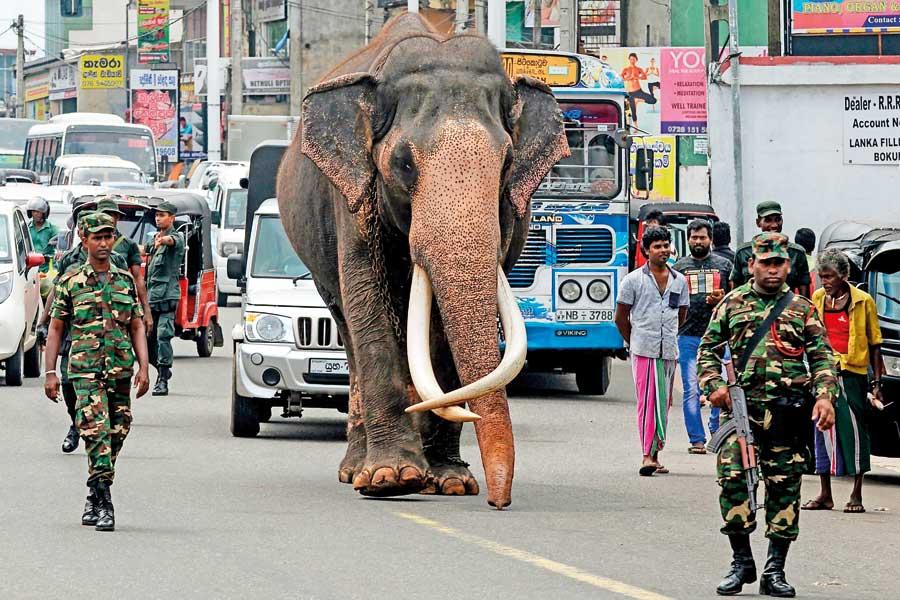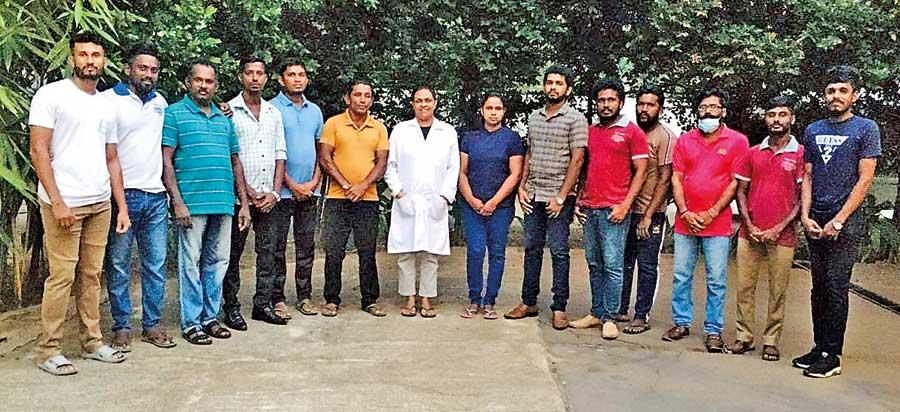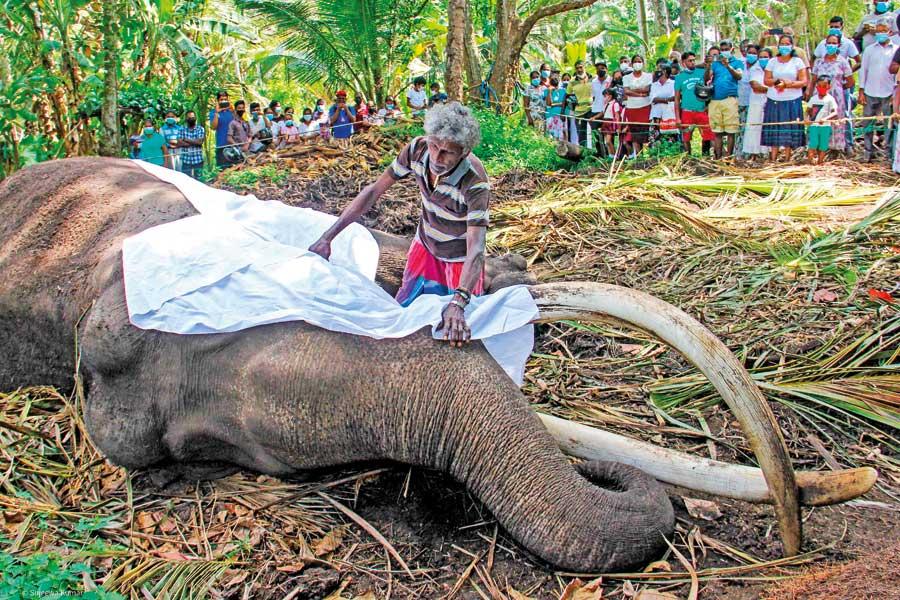23 Mar 2022 - {{hitsCtrl.values.hits}}

Majestic Raja
Sri Lankans venerated the 11-foot tall Nadungamuwa Raja every time it took to the streets to attend a pageant, either in Kandy or elsewhere in the island. Unlike other domesticated elephants that paraded the streets in pageants, Raja was known to be calm in its spirits, obeying its caretaker Wilson Kodithuwakku’s commands. People attributed its behaviours to the merits it has accumulated in a previous birth; quite a Sri Lankan way of acknowledging a living being that stays close to humans when in reality such behaviours are portrayed as a result of ‘breaking the spirit’ of an animal. Ever since 2005, Raja was the centre of attraction at the Kandy Esala Perahera as it carried the casket with relics belonging to the Temple of the Tooth (Dalada Maligawa). Ending its 17 years of service to the temple, Raja breathed its last on March 7, 2022 putting an entire nation into grief.
pageant, either in Kandy or elsewhere in the island. Unlike other domesticated elephants that paraded the streets in pageants, Raja was known to be calm in its spirits, obeying its caretaker Wilson Kodithuwakku’s commands. People attributed its behaviours to the merits it has accumulated in a previous birth; quite a Sri Lankan way of acknowledging a living being that stays close to humans when in reality such behaviours are portrayed as a result of ‘breaking the spirit’ of an animal. Ever since 2005, Raja was the centre of attraction at the Kandy Esala Perahera as it carried the casket with relics belonging to the Temple of the Tooth (Dalada Maligawa). Ending its 17 years of service to the temple, Raja breathed its last on March 7, 2022 putting an entire nation into grief.

The livewires behind the preservation process of Nadungamuwa Raja
"I believe that it would take at least six months to complete the preservation process of Nadungamuwa Raja. We requested the crowd to refrain from releasing footage to the public at the time we commenced the skin-out process. This is because we believed that people shouldn’t see sensitive images as the public highly venerated this animal - Sanuja Kasthuriarachchi, Director General at the Department of National Museums"
Gift from India
Raja was born in Mysore back in 1954 and was owned by Maharaja Jayachamajendra Wadiyar. A Buddhist monk at the Boralesgamuwa Neelammahara Temple who was also a renowned physician was vested with the task of curing the Maharaja; who was diagnosed with an illness. Since the monk succeeded in curing the illness, the Maharaja had gifted two elephants to this monk. One of them was Raja. The guardian of the other elephant, Navam Hasthi, was Ven. Galaboda Gnanissara Thera, the Chief Incumbent of the Gangarama Temple. In 1978 Dharmavijaya Veda Ralahamy of Nadungamuwa, an Ayurveda practitioner, had bought the elephant from Horana. The elephant was later owned by his son Dr. Harsha Dharmavijaya until its demise.
Essential process of skin removal
Following its demise the Department of National Museums was vested with the task of preserving this national icon. “Taxidermy is a complex process and needs much patience,” opined Sanuja Kasthuriarachchi, Director General at the Department of National Museums. “I believe that it would take at least six months to complete the preservation process of Nadungamuwa Raja. We requested the crowd to refrain from releasing footage to the public at the time we commenced the skin-out process. This is because we believed that people shouldn’t see sensitive images as the public highly venerated this animal. If we are to restore an animal in terms of taxidermy then it’s a must to remove the skin. Otherwise the animal should be buried. But due to cultural ideologies we thought it’s not necessary to reveal initial footage. We were able to showcase Millangoda Raja to the younger generations and educate them on its service to the nation. But this wouldn’t have been possible if it was buried. Without criticising people should learn to wait till they see the final product,” said Kasthuriarachchi.
"He was entertaining and serving a human purpose. With his body being preserved we are getting it’s dead body to serve humans. As per Buddha’s teachings people should learn to let go, but here they are hanging on to its dead body to serve a human purpose - Panchali Panapitiya of Rally for Animal Rights and Environment"
Irresponsible social media
Taxidermy is a way of preserving animals and it’s a dry method. It attempts to portray an actual representation of the animal similarly to its living avatar. “In the case of Raja we are trying to showcase a popular posture of the animal at the time it was alive,” said Lankani Somaratne, Colombo National Museum Assistant Director. “Therefore it’s a must to remove the skin of an animal. We take the skin within 12 hours of an animal’s death and preserve it. Many chemicals are used in this process and later on we use this skin on a dummy of the animal. The technology that is being used in the process gets updated from time to time,” explained Somaratne.
However a few videos and photos of the animal being skinned following its death went viral on social media. “This footage was made viral sans our knowledge. It’s difficult to control social media usage. Some people don’t know about taxidermy and the public was misled. The skull and the skin of an animal are most important during the taxidermy process. We discard the flesh and bones. In the case of a leopard we need its teeth, nails etc. In the case of an elephant we need the tusks. We don’t use any other body part. But if we are developing a skeleton we make use of its actual skeleton, but in any case we discard the flesh,” said Somaratne.
"A few videos and photos of the animal being skinned following its death went viral on social media"
When photos of an incomplete black leopard went viral on social media, the public expressed their disappointment towards the taxidermists. But that photo was taken when the taxidermy process was in its initial stages. At present an elegant version of the black leopard stands tall inside the taxidermy section of the museum; still undergoing certain fixes and brush ups prior to its official public display. “Until we complete the process we can’t predict how the final product is going to be. We have the most experienced taxidermists at the museum,” she added.
“There are certain tasks to be completed such as preparing the dummy etc., prior to commencing the process,” she said while reasoning out why it would take at least six months to complete the process. “We are going to make maximum use of technology available here. Taking the skin and skull is a must in taxidermy, but because this animal is a national icon people gave more attention to the footage.
“The preservation commenced following a request by the Presidential Secretariat that was directed to the Ministry of Buddhasasana, Religious and Cultural Affairs. We received the message a few hours following its death and the biggest challenge was to preserve its skin within the limited time frame. I like to extend my sincere thanks to the Director General Sanuja Kasthuriarachchi, Manori Gunathilaka - Acting Director (Science) and the team of 14 members led by Chamalka Kothelawala (taxidermist), Ravindra Wickramanayaka, Susantha Balasuriya and Thushari Dassanayake who assisted in this task. If not for their collective effort, we wouldn’t have been able to complete the initial stages of the process this soon,” she added.

Wilson Kodithuwakku who took care of Raja pays his respects to the deceased animal
Skin preservation complete
The biggest challenge for Chamalka Kothelawala and the team was to ensure that the skin was taken off without causing any damage. “Prior to the preservation process we prepare sketches, line drawings and then take the measurements of an animal,” opined Kothelawala, the only female taxidermist for South Asia. “When we received the message on Monday (March 7) morning we gathered the team and prepared all materials required for the process. By the time we reached the location and commenced the process it was around 11.00pm because we didn’t want the crowd to interfere. The skin-out process was completed during the afternoon hours the following day. We buried the skull and tusks and it took around 10 days to preserve the skin. The team worked long hours and some even worked until 4.00am. There’s a thick layer of fat under their skin and this needs to be removed carefully. It took around two weeks to complete this task on Millangoda Raja but we were able to complete it in 10 days. The skin is then dipped in a chemical bath.
"Several unspoken issues arise following the demise of Raja and they need to be discussed in order to streamline the management of domesticated elephants"
“We exhume the skull after two months but the flesh won’t be decayed by then. Therefore we have to remove all the flesh. We also cannot separate the tusks without causing damage to the skull. This is why it’s buried and thereafter we can fix it into the cavity. Back in the day the skin was dried manually, but now we freeze the skin and incorporate new technologies to get the final product. Once frozen it’s easier to drag the skin. Maintenance-wise a preserved skin needs to be retouched every five years. Once preserved, the dummy should be kept in an air-conditioned room. The temperature, humidity and light affect the preserved skin on any animal. Therefore when removing the skin one has to ensure that it’s not damaged. We had to ensure that the skin didn’t get dried. Another challenge was that the process was done outdoors. But right now the skin has been preserved and we will move into the next stage soon,” she added.
"According to the controversial regulation on the Protection, Welfare and Registration of Domestic Elephants No. 1 of 2021, elephants should not be used for any purpose after the age of 60 years. However, the Nadungamuwe tusker, who died at the age of 69, was used for the recently concluded religious festival in Temple of the Sacred Tooth Relic even last year - Supun Lahiru Prakash Convener – Biodiversity and Research Circle"
Raja continues to serve humans
The dialogue on domesticating elephants has sparked much debate among the animal rights fraternity in the country. Even though there are around 100 domesticated elephants in the country, many believe that they belong in the wilds and should be allowed to remain in their own habitats.
“Nadungamuwa Raja was serving humans and was living as an object of humans,” opined Panchali Panapitiya of Rally for Animal Rights and Environment (RARE). “He was entertaining and serving a human purpose. With his body being preserved we are getting it’s dead body to serve humans. As per Buddha’s teachings people should learn to let go, but here they are hanging on to its dead body to serve a human purpose,” said Panapitiya.
Protecting the rights of captive elephants
Concerns have also been raised with regards to the violation of Raja’s fundamental right to reproduce as a result of being a domesticated elephant. When photos of an emaciated Tikiri, a 70-year-old tusker that paraded the streets during the Kandy Esala Perahera, concerns were raised regarding the age of elephants used in pageants. “According to the controversial regulation on the Protection, Welfare and Registration of Domestic Elephants No. 1 of 2021, elephants should not be used for any purpose after the age of 60 years. However, the Nadungamuwe tusker, who died at the age of 69, was used for the recently concluded religious festival in Temple of the Sacred Tooth Relic even last year,” opined Supun Lahiru Prakash, Convener – Biodiversity and Research Circle.
"Concerns have also been raised with regards to the violation of Raja’s fundamental right to reproduce as a result of being a domesticated elephant"
As such several unspoken issues arise following the demise of Raja and these need to be discussed in order to streamline the management of domesticated elephants. “We urge the enactment of a national policy on captive elephants which introduces a scientific and transparent process regarding the registration and renewal of licenses to hold captive elephants. This should lead to a limit on the use of captive elephants for cultural, religious, and tourism purposes. Using them for tourism, logging, political events and wedding ceremonies should not be promoted. Even using them in little processions in temples, Dhamma Schools, and Katina Pinkama should not be promoted. We urge the authorities responsible for the welfare and conservation of Asian elephants in Sri Lanka to adopt the standardised captive elephant registration protocols and best practices proposed by the Seventeenth Conference of Parties of CITES in 2016 and the second Asian Elephant Range States’ meeting in 2017. These guidelines include DNA registration, monitoring protocols for captive populations, guidelines for the management and welfare of captive elephants, disease management including zoonotic diseases, training and capacity building of staff and mahouts, and specific national policy to manage the captive elephant population to avoid illicit live elephant trade. These new protocols may discourage the malpractices associated with the illegal trade of wild Asian elephants and secure the welfare of captive Asian elephants in Sri Lanka,” said Prakash.
26 Nov 2024 8 minute ago
26 Nov 2024 12 minute ago
26 Nov 2024 16 minute ago
25 Nov 2024 25 Nov 2024
25 Nov 2024 25 Nov 2024